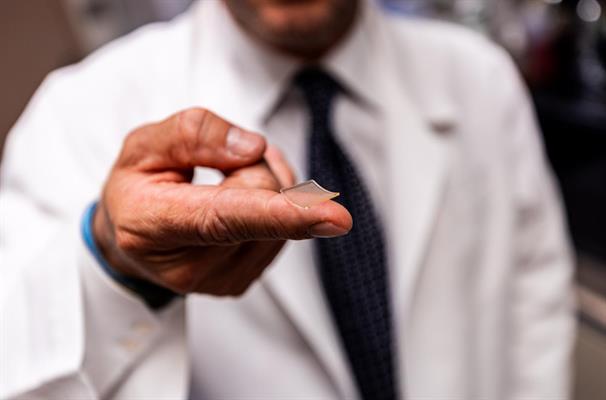April 3, 2020 -- Within four weeks of the SARS-CoV-2 spike sequence becoming available, researchers from the University of Pittsburgh School of Medicine developed immunogens for a potential COVID-19 vaccine. The vaccine is delivered through a fingertip-sized patch, and it produces antibodies specific to SARS-CoV-2 at quantities thought to be sufficient for neutralizing the virus, according to the April 2 EBioMedicine publication.
The groundwork for the vaccine was already laid with previous experience and research on spike proteins for SARS-CoV in 2003 and MERS-CoV in 2014, said the authors.
"We knew exactly where to fight this new virus," said co-author Dr. Andrea Gambotto, associate professor of surgery at the University of Pittsburgh School of Medicine, in a statement "That's why it's important to fund vaccine research. You never know where the next pandemic will come from."
Based on previous research, the team demonstrated that adenoviral vaccine candidates expressing SARS-CoV N-terminal surface subunit (S1) and MERS-CoV-S1 induce a more powerful neutralizing effect compared with the full spike protein. Moreover, the researchers know that in its native state, spike proteins exist as a trimeric form on the surface of the virus. But when they are produced in recombinant systems, they are predominantly in the monomeric form.
Armed with knowledge and experience, the researchers were able to rapidly develop a new vaccine for SARS-CoV-2.
Building the vaccine components
First, the researchers developed a version of the MERS-S1 vaccine. To make the trimeric recombinant subunit proteins, MERS-CoV-S1 was fused to a 27-amino-acid sequence called the foldon domain, which is a natural trimerization domain derived from the bacteriophage T4 fibritin. The foldon domain has been shown to mimic native viral trimeric structures, making it a strong immunogenicity agent.
The University of Pittsburgh's coronavirus vaccine was designed with a six-histidine tag and a Tobacco Etch Virus (TEV) protease cleavage sequence at the carboxy terminus to allow for metal chelating affinity purification and to facilitate downstream large-scale purification for manufacturing. To delete the tag, the purified recombinant proteins were treated with AcTEV protease followed by affinity chromatography on a nickel chelating resin.
The cleaved native recombinant proteins were collected from the flow-through fraction and used as coating antigens. In mouse models, three recombinant MERS-S1 proteins had strong reactivity with MERS-S1-specific antibodies.
Based on these MERS-S1 vaccine results, the team urgently focused their efforts on the development of a SARS-CoV-2-S1 subunit vaccine. Using the same procedures, the SARS-CoV-2-S1 recombinant proteins were constructed. The size and trimerization product of the vaccine was confirmed by western blot.
Vaccine delivery
Dissolving microneedle arrays (MNAs) have emerged as a minimally invasive approach to delivering potent vaccine components to elicit an adaptive immune response. The arrays were developed from mechanically strong water-soluble polymers that breach the outermost layer of skin and then rapidly dissolve.

The skin is an ideal target for immunization because it contains a rich population of antigen-presenting and immune-accessory cells. The fingertip-sized patch designed by the researchers contains 400 tiny polymer needles that can be applied like a Band-Aid.
Once the vaccines were loaded into the MNAs, they were used to vaccinate mice with the SARS-CoV-2-S1. Blood sera were collected prior to immunization and for four consecutive weeks and were evaluated for the presence of SARS-CoV-2-S1 specific antibodies by ELISA. The researchers found that MNA delivery was effective in eliciting neutralizing antibodies. As soon as week two, the vaccine induced substantial increases in antigen-specific responses.
The scalability issue
During the rapid development of the SARS-CoV-2 vaccine, the researchers always had scalability in mind.
"For most vaccines, you don't need to address scalability to begin with," Gambotto said. "But when you try to develop a vaccine quickly against a pandemic that's the first requirement."
The team used good manufacturing processes (GMP) to produce, purify, validate, and incorporate the S1 subunits into the dissolvable MNAs. The system was developed with mass clinical production and quality assurance considerations. Moreover, once developed, the vaccine can be stored at room temperature, eliminating the need for "cold chain" requirements.
The authors are in the process of applying for an investigational new drug approval from the U.S. Food and Drug Administration and expect to start a phase I clinical trial in the coming months.
"Our ability to rapidly develop this vaccine was a result of scientists with expertise in diverse areas of research working together with a common goal," said co-author Dr. Louis Falo, PhD, professor and chair of dermatology at the Pittsburgh School of Medicine and the University of Pittsburgh Medical Center.
Do you have a unique perspective on your research related to virology or biomanufacturing? Contact the editor today to learn more.
Copyright © 2020 scienceboard.net


